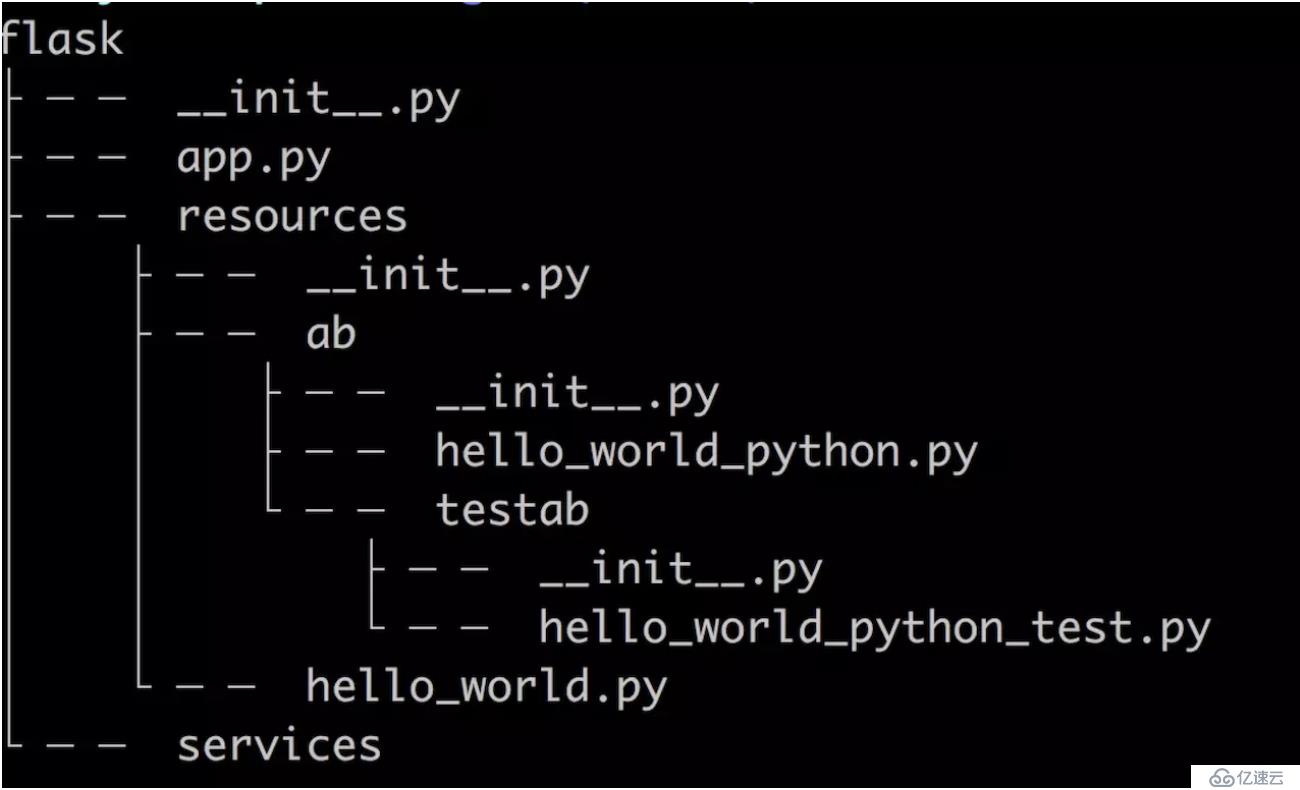随着业务的飞速发展,API接口越来越多,路由管理文件从几十号变成几百上千行,且每次上新服务,需要在修改路由文件代码,带来一定的风险。

制定对应规则,路由通过API文件名根据一定的规则对应类名,然后自动导入对应实现类,注册到Web框架中。
下面这套规则只是其中一种方案,可以针对项目情况制定对应的规则,然后实现相关代码,但是整体思路基本一样。
代码目录结构,列一下简单的项目文件目录,下面以flask框架为例:
app.py是启动文件。
resources是API接口代码文件夹。
services是为API接口服务的函数封装文件夹。
如果项目还有依赖文件,也可以单独再建其他文件夹。
项目的API接口代码均放在resources文件夹下,且此文件夹只能写接口API服务代码。
接口名称命名以_连接单词,而对应文件里的类名文件名称的单词,不过换成是驼峰写法。
规则举例如下:
如上图,resources下有一个hello_world接口,还有一个ab项目文件夹,ab下面还有一个hello_world_python接口以及子项目文件夹testab, testab下面也有一个hello_world_python.
接口文件的文件名命名规范:
文件名命名均为小写,多个单词之间使用'_'隔开,比如hello_world.py 命名正确,helloWorld.py命名错误。


路由入口文件会自动映射,映射规则为:
前缀 / 项目文件夹[...] / 文件名
其中 前缀为整个项目的路由前缀,可以定义,也可以不定义,比如api-ab项目,可以定义整个项目的路由前缀为 ab/
resource下面项目文件夹如果有,则会自动拼接,如果没有,则不会读取。
举例:
前缀为空,上图resources中的三个接口对应的路由为:
hello_world.py ==> /hello_world ab/hello_world_python.py ==> /ab/hello_world_python ab/testab/hello_world_python.py ==> /ab/testab/hello _world_python
前缀为ab/,上图resources中的三个接口对应的路由为:
hello_world.py ==> ab/hello_world ab/hello_world_python.py ==> ab/ab/hello_world_python ab/testab/hello_world_python.py ==> ab/ab/testab/hello_world_python
python很多框架的启动和路由管理都很类似,所以这套规则适合很多框架,测试过程中有包括flask, tornado, sanic, japronto。 以前年代久远的web.py也是支持的。
完整代码地址:
https://github.com/CrystalSkyZ/PyAutoApiRoute
实现下划线命名 转 驼峰命名 函数,代码演示:
def underline_to_hump(underline_str):
'''
下划线形式字符串转成驼峰形式,首字母大写
'''
sub = re.sub(r'(_\w)', lambda x: x.group(1)[1].upper(), underline_str)
if len(sub) > 1:
return sub[0].upper() + sub[1:]
return sub实现根据字符串导入模块函数, 代码演示:
通过python内置函数__import__函数实现加载类
def import_object(name):
"""Imports an object by name.
import_object('x') is equivalent to 'import x'.
import_object('x.y.z') is equivalent to 'from x.y import z'.
"""
if not isinstance(name, str):
name = name.encode('utf-8')
if name.count('.') == 0:
return __import__(name, None, None)
parts = name.split('.')
obj = __import__('.'.join(parts[:-1]), None, None, [parts[-1]], 0)
try:
return getattr(obj, parts[-1])
except AttributeError:
raise ImportError("No module named %s" % parts[-1])importlib.import_module(name)上面2种方法都可以,github上代码里2种方法都有测试。
检索resources文件夹,生成路由映射,并导入对应实现类, 代码演示如下:
def route(route_file_path,
resources_name="resources",
route_prefix="",
existing_route=None):
route_list = []
def get_route_tuple(file_name, route_pre, resource_module_name):
"""
:param file_name: API file name
:param route_pre: route prefix
:param resource_module_name: resource module
"""
nonlocal route_list
nonlocal existing_route
route_endpoint = file_name.split(".py")[0]
#module = importlib.import_module('{}.{}'.format(
# resource_module_name, route_endpoint))
module = import_object('{}.{}'.format(
resource_module_name, route_endpoint))
route_class = underline_to_hump(route_endpoint)
real_route_endpoint = r'/{}{}'.format(route_pre, route_endpoint)
if existing_route and isinstance(existing_route, dict):
if real_route_endpoint in existing_route:
real_route_endpoint = existing_route[real_route_endpoint]
route_list.append((real_route_endpoint, getattr(module, route_class)))
def check_file_right(file_name):
if file_name.startswith("_"):
return False
if not file_name.endswith(".py"):
return False
if file_name.startswith("."):
return False
return True
def recursive_find_route(route_path, sub_resource, route_pre=""):
nonlocal route_prefix
nonlocal resources_name
file_list = os.listdir(route_path)
if config.DEBUG:
print("FileList:", file_list)
for file_item in file_list:
if file_item.startswith("_"):
continue
if file_item.startswith("."):
continue
if os.path.isdir(route_path + "/{}".format(file_item)):
recursive_find_route(route_path + "/{}".format(file_item), sub_resource + ".{}".format(file_item), "{}{}/".format(route_pre, file_item))
continue
if not check_file_right(file_item):
continue
get_route_tuple(file_item, route_prefix + route_pre, sub_resource)
recursive_find_route(route_file_path, resources_name)
if config.DEBUG:
print("RouteList:", route_list)
return route_list以flask框架为例,其余框架请看github中的代码演示。
app.py 中代码
app = Flask(__name__)
api = Api(app)
# APi route and processing functions
exist_route = {"/flask/hello_world": "/hello_world"}
route_path = "./resources"
route_list = route(
route_path,
resources_name="resources",
route_prefix="flask/",
existing_route=exist_route)
for item in route_list:
api.add_resource(item[1], item[0])
if __name__ == "__main__":
app.run(host="0.0.0.0", port=int(parse_args.port), debug=config.DEBUG)运行app.py之后,路由打印如下:
RouteList: [
('/hello_world', <class'resources.hello_world.HelloWorld'>),
('/flask/ab/testab/hello_world_python_test', \
<class 'resources.ab.testab.hello_world_python_test.HelloWorldPythonTest'>),
('/flask/ab/hello_world_python', <class 'resources.ab.hello_world_python.HelloWorldPython'>)
]元组第一个元素则是路由,第二个元素是对应的实现类。
总结:
至此,通过制定一定规则,解放路由管理文件方案完成。 欢迎各位一起讨论其余比较好的方案,更多方案讨论可以关注微信公众号: 天澄的技术笔记 。 
亿速云「云服务器」,即开即用、新一代英特尔至强铂金CPU、三副本存储NVMe SSD云盘,价格低至29元/月。点击查看>>
免责声明:本站发布的内容(图片、视频和文字)以原创、转载和分享为主,文章观点不代表本网站立场,如果涉及侵权请联系站长邮箱:is@yisu.com进行举报,并提供相关证据,一经查实,将立刻删除涉嫌侵权内容。